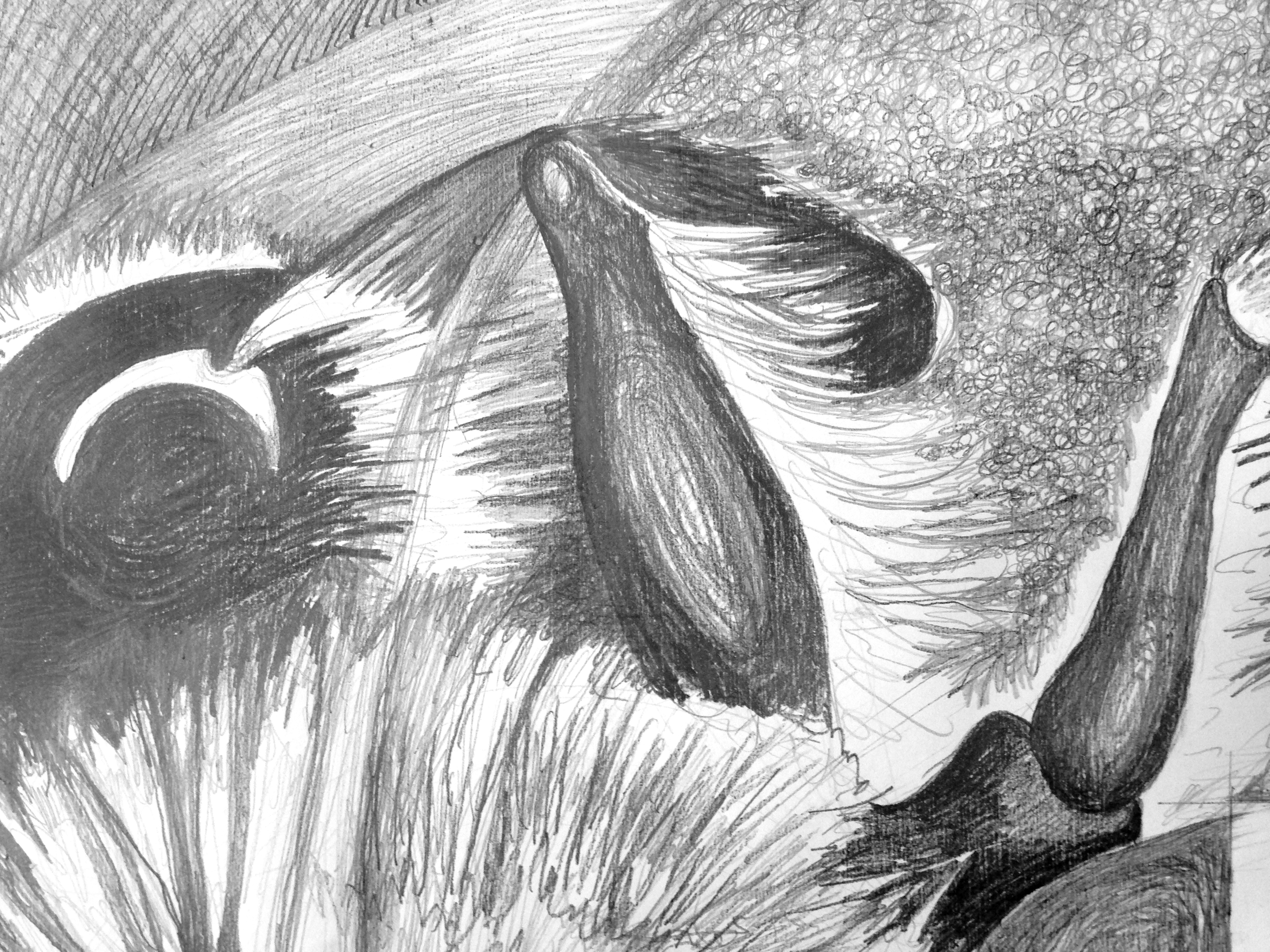About Bridget

Bridget Parlato is a designer/artist/activist based in urban southeast Baltimore, MD. She runs Full Circuit Studio as a freelance designer specializing in cause-related work. She also heads up Baltimore Trash Talk, an anti-trash activism initiative that works towards raising awareness and seeking behavioral change through digital and print campaigns, sculptures, public events, performances, installations and school outreach.
Apart from her graphic portfolio, Parlato’s personal work… more
Jump to a project:
Predators or Prey? - The Outside (Bug Girls)
Predators or Prey? was a solo exhibition investigating the way women are encouraged to present themselves on the outside while trying to figure out who we are on the inside.
The show contrasted two sets of digital collages. The first group examined women comprised of magazine parts and depicted as insect specimens with latin names. These specimens had no vs. my views of myself as influenced by my own experiences as a woman, daughter and mother who grew up in a home where my mother suffered from clinical depression for most of my life.
Hints at that depression surface in most of the self portraits. "Blue" speaks more softly of depressions tendencies to draw one to the bed to sleep and escape while shock treatment head gear and representations of electric current are apparent in "Which Ones Are These?".
Passive or powerful? Authenticity or artifice? Victim or vixen? Self-reliant or subordinate? Influence, impact, process, fabricate, display - what shapes who we are and how much is choice? Such questions are the basis for this collection of images that investigate person and persona. Through gritty interior portraits and slick specimens from the grocery check-out rack, the artist examines self and sexuality on the feminine front.
The show contrasted two sets of digital collages. The first group examined women comprised of magazine parts and depicted as insect specimens with latin names. These specimens had no vs. my views of myself as influenced by my own experiences as a woman, daughter and mother who grew up in a home where my mother suffered from clinical depression for most of my life.
Hints at that depression surface in most of the self portraits. "Blue" speaks more softly of depressions tendencies to draw one to the bed to sleep and escape while shock treatment head gear and representations of electric current are apparent in "Which Ones Are These?".
Passive or powerful? Authenticity or artifice? Victim or vixen? Self-reliant or subordinate? Influence, impact, process, fabricate, display - what shapes who we are and how much is choice? Such questions are the basis for this collection of images that investigate person and persona. Through gritty interior portraits and slick specimens from the grocery check-out rack, the artist examines self and sexuality on the feminine front.
-
 Predators or Prey - Divitis Illecebrosa PraemiumRich, Attractive, Prize. “Passive or powerful? Authenticity or artifice? Victim or vixen? Self-reliant or subordinate? Influence, impact, process, fabricate, display - what shapes who we are and how much is choice? These digital images are from a solo exhibition called “Predators or Prey?”. The show’s gritty self portraits portray the interior of the artist as a person,while the insect influenced images (comprised wholly of women’s magazine imagery) represent women as specimens created by the dictates of contemporary mainstream media. Person vs. persona.
Predators or Prey - Divitis Illecebrosa PraemiumRich, Attractive, Prize. “Passive or powerful? Authenticity or artifice? Victim or vixen? Self-reliant or subordinate? Influence, impact, process, fabricate, display - what shapes who we are and how much is choice? These digital images are from a solo exhibition called “Predators or Prey?”. The show’s gritty self portraits portray the interior of the artist as a person,while the insect influenced images (comprised wholly of women’s magazine imagery) represent women as specimens created by the dictates of contemporary mainstream media. Person vs. persona. -
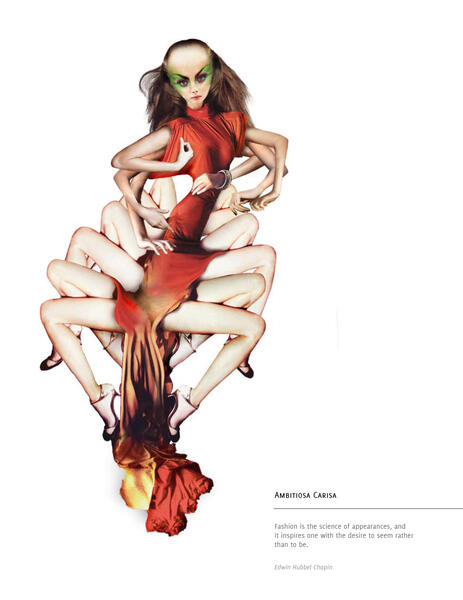 Predators or Prey - Ambitiosa CarisaArtful, Sly, Showy. “Passive or powerful? Authenticity or artifice? Victim or vixen? Self-reliant or subordinate? Influence, impact, process, fabricate, display - what shapes who we are and how much is choice? These digital images are from a solo exhibition called “Predators or Prey?”. The show’s gritty self portraits portray the interior of the artist as a person,while the insect influenced images (comprised wholly of women’s magazine imagery) represent women as specimens created by the dictates of contemporary mainstream media. Person vs. persona.
Predators or Prey - Ambitiosa CarisaArtful, Sly, Showy. “Passive or powerful? Authenticity or artifice? Victim or vixen? Self-reliant or subordinate? Influence, impact, process, fabricate, display - what shapes who we are and how much is choice? These digital images are from a solo exhibition called “Predators or Prey?”. The show’s gritty self portraits portray the interior of the artist as a person,while the insect influenced images (comprised wholly of women’s magazine imagery) represent women as specimens created by the dictates of contemporary mainstream media. Person vs. persona. -
 Predators or Prey - Artificiosus Opima PomiSkillfully Crafted, Fertile Fruit. “Passive or powerful? Authenticity or artifice? Victim or vixen? Self-reliant or subordinate? Influence, impact, process, fabricate, display - what shapes who we are and how much is choice? These digital images are from a solo exhibition called “Predators or Prey?”. The show’s gritty self portraits portray the interior of the artist as a person,while the insect influenced images (comprised wholly of women’s magazine imagery) represent women as specimens created by the dictates of contemporary mainstream media. Person vs. persona.
Predators or Prey - Artificiosus Opima PomiSkillfully Crafted, Fertile Fruit. “Passive or powerful? Authenticity or artifice? Victim or vixen? Self-reliant or subordinate? Influence, impact, process, fabricate, display - what shapes who we are and how much is choice? These digital images are from a solo exhibition called “Predators or Prey?”. The show’s gritty self portraits portray the interior of the artist as a person,while the insect influenced images (comprised wholly of women’s magazine imagery) represent women as specimens created by the dictates of contemporary mainstream media. Person vs. persona. -
 Predators or Prey - Appetitio Aviditas AraneaAspiring, greedy, spider. “Passive or powerful? Authenticity or artifice? Victim or vixen? Self-reliant or subordinate? Influence, impact, process, fabricate, display - what shapes who we are and how much is choice? These digital images are from a solo exhibition called “Predators or Prey?”. The show’s gritty self portraits portray the interior of the artist as a person,while the insect influenced images (comprised wholly of women’s magazine imagery) represent women as specimens created by the dictates of contemporary mainstream media. Person vs. persona.
Predators or Prey - Appetitio Aviditas AraneaAspiring, greedy, spider. “Passive or powerful? Authenticity or artifice? Victim or vixen? Self-reliant or subordinate? Influence, impact, process, fabricate, display - what shapes who we are and how much is choice? These digital images are from a solo exhibition called “Predators or Prey?”. The show’s gritty self portraits portray the interior of the artist as a person,while the insect influenced images (comprised wholly of women’s magazine imagery) represent women as specimens created by the dictates of contemporary mainstream media. Person vs. persona. -
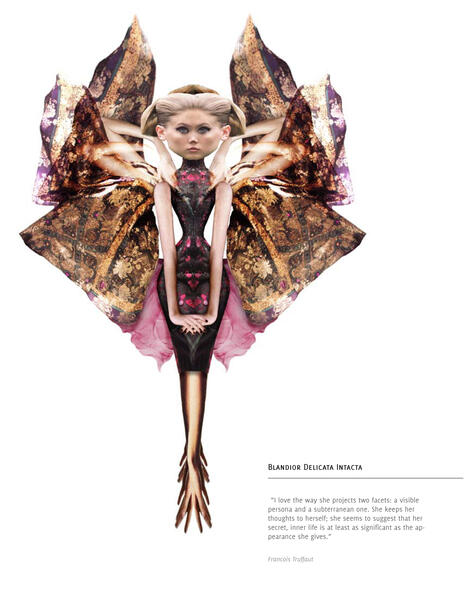 Predators or Prey - Blandior Delicata IntactaFlattering, Frivilous Virgin. “Passive or powerful? Authenticity or artifice? Victim or vixen? Self-reliant or subordinate? Influence, impact, process, fabricate, display - what shapes who we are and how much is choice? These digital images are from a solo exhibition called “Predators or Prey?”. The show’s gritty self portraits portray the interior of the artist as a person,while the insect influenced images (comprised wholly of women’s magazine imagery) represent women as specimens created by the dictates of contemporary mainstream media. Person vs. persona.
Predators or Prey - Blandior Delicata IntactaFlattering, Frivilous Virgin. “Passive or powerful? Authenticity or artifice? Victim or vixen? Self-reliant or subordinate? Influence, impact, process, fabricate, display - what shapes who we are and how much is choice? These digital images are from a solo exhibition called “Predators or Prey?”. The show’s gritty self portraits portray the interior of the artist as a person,while the insect influenced images (comprised wholly of women’s magazine imagery) represent women as specimens created by the dictates of contemporary mainstream media. Person vs. persona. -
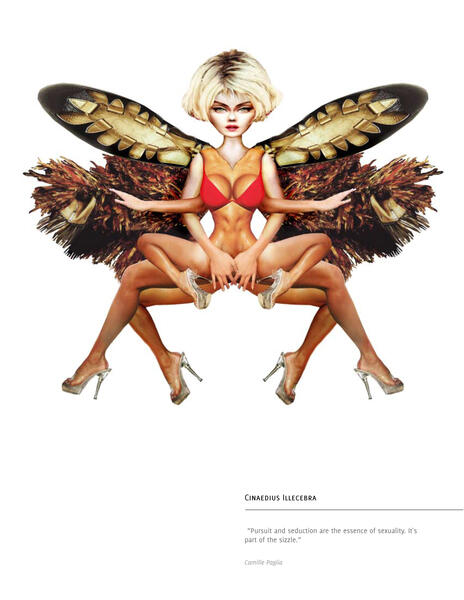 Predators or Prey - Cinaedius IllecebraLewd, Immodest Enticement. “Passive or powerful? Authenticity or artifice? Victim or vixen? Self-reliant or subordinate? Influence, impact, process, fabricate, display - what shapes who we are and how much is choice? These digital images are from a solo exhibition called “Predators or Prey?”. The show’s gritty self portraits portray the interior of the artist as a person,while the insect influenced images (comprised wholly of women’s magazine imagery) represent women as specimens created by the dictates of contemporary mainstream media. Person vs. persona.
Predators or Prey - Cinaedius IllecebraLewd, Immodest Enticement. “Passive or powerful? Authenticity or artifice? Victim or vixen? Self-reliant or subordinate? Influence, impact, process, fabricate, display - what shapes who we are and how much is choice? These digital images are from a solo exhibition called “Predators or Prey?”. The show’s gritty self portraits portray the interior of the artist as a person,while the insect influenced images (comprised wholly of women’s magazine imagery) represent women as specimens created by the dictates of contemporary mainstream media. Person vs. persona. -
 Predators or Prey - Sireneus Corum EdaxGreedy, Voracious, Direct Siren. “Passive or powerful? Authenticity or artifice? Victim or vixen? Self-reliant or subordinate? Influence, impact, process, fabricate, display - what shapes who we are and how much is choice? These digital images are from a solo exhibition called “Predators or Prey?”. The show’s gritty self portraits portray the interior of the artist as a person,while the insect influenced images (comprised wholly of women’s magazine imagery) represent women as specimens created by the dictates of contemporary mainstream media. Person vs. persona.
Predators or Prey - Sireneus Corum EdaxGreedy, Voracious, Direct Siren. “Passive or powerful? Authenticity or artifice? Victim or vixen? Self-reliant or subordinate? Influence, impact, process, fabricate, display - what shapes who we are and how much is choice? These digital images are from a solo exhibition called “Predators or Prey?”. The show’s gritty self portraits portray the interior of the artist as a person,while the insect influenced images (comprised wholly of women’s magazine imagery) represent women as specimens created by the dictates of contemporary mainstream media. Person vs. persona. -
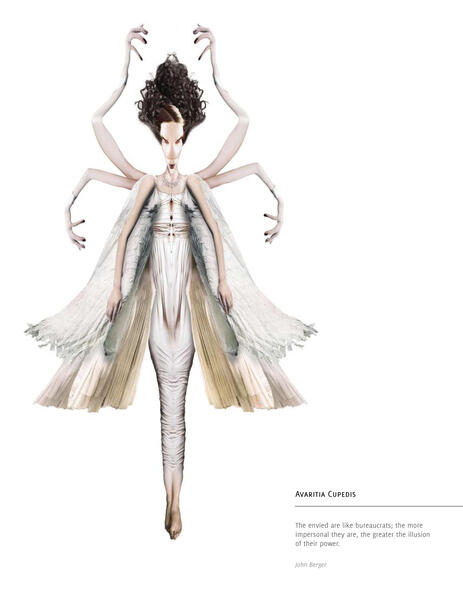 Predators or Prey - Avaritia CupidisGreedy Lover. “Passive or powerful? Authenticity or artifice? Victim or vixen? Self-reliant or subordinate? Influence, impact, process, fabricate, display - what shapes who we are and how much is choice? These digital images are from a solo exhibition called “Predators or Prey?”. The show’s gritty self portraits portray the interior of the artist as a person,while the insect influenced images (comprised wholly of women’s magazine imagery) represent women as specimens created by the dictates of contemporary mainstream media. Person vs. persona.
Predators or Prey - Avaritia CupidisGreedy Lover. “Passive or powerful? Authenticity or artifice? Victim or vixen? Self-reliant or subordinate? Influence, impact, process, fabricate, display - what shapes who we are and how much is choice? These digital images are from a solo exhibition called “Predators or Prey?”. The show’s gritty self portraits portray the interior of the artist as a person,while the insect influenced images (comprised wholly of women’s magazine imagery) represent women as specimens created by the dictates of contemporary mainstream media. Person vs. persona. -
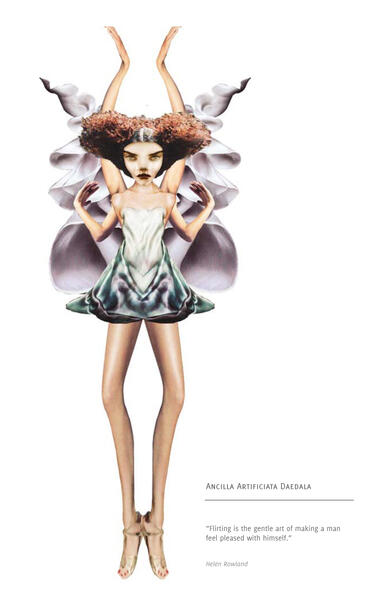 Predators or Prey - Ancilla Artificiata DaedalaArtificial Skillfully crafted Maidservant. “Passive or powerful? Authenticity or artifice? Victim or vixen? Self-reliant or subordinate? Influence, impact, process, fabricate, display - what shapes who we are and how much is choice? These digital images are from a solo exhibition called “Predators or Prey?”. The show’s gritty self portraits portray the interior of the artist as a person,while the insect influenced images (comprised wholly of women’s magazine imagery) represent women as specimens created by the dictates of contemporary mainstream media. Person vs. persona.
Predators or Prey - Ancilla Artificiata DaedalaArtificial Skillfully crafted Maidservant. “Passive or powerful? Authenticity or artifice? Victim or vixen? Self-reliant or subordinate? Influence, impact, process, fabricate, display - what shapes who we are and how much is choice? These digital images are from a solo exhibition called “Predators or Prey?”. The show’s gritty self portraits portray the interior of the artist as a person,while the insect influenced images (comprised wholly of women’s magazine imagery) represent women as specimens created by the dictates of contemporary mainstream media. Person vs. persona. -
 Predators or Prey? - Formidulosus Trepidans LibidinisTerrible, Anxious Lust. “Passive or powerful? Authenticity or artifice? Victim or vixen? Self-reliant or subordinate? Influence, impact, process, fabricate, display - what shapes who we are and how much is choice? These digital images are from a solo exhibition called “Predators or Prey?”. The show’s gritty self portraits portray the interior of the artist as a person,while the insect influenced images (comprised wholly of women’s magazine imagery) represent women as specimens created by the dictates of contemporary mainstream media. Person vs. persona.
Predators or Prey? - Formidulosus Trepidans LibidinisTerrible, Anxious Lust. “Passive or powerful? Authenticity or artifice? Victim or vixen? Self-reliant or subordinate? Influence, impact, process, fabricate, display - what shapes who we are and how much is choice? These digital images are from a solo exhibition called “Predators or Prey?”. The show’s gritty self portraits portray the interior of the artist as a person,while the insect influenced images (comprised wholly of women’s magazine imagery) represent women as specimens created by the dictates of contemporary mainstream media. Person vs. persona.
Pollinators and Neonicotinoids
This series of drawings focuses on the problem of neonicotinoid pesticides and pollinators.
Neonicotinoids are a class of insecticides chemically related to nicotine that act on receptors in the nerve synapse. They are toxic to insects, mammals, birds and other higher organisms. Marketed by European chemical giants Syngenta and Bayer, neonics are the most widely used insecticides both in the United States and globally. In a report released a year ago, the EPA basically conceded the case that these pesticides harm bees and other pollinators. They still remain on the market.
Neonicotinoids are a class of insecticides chemically related to nicotine that act on receptors in the nerve synapse. They are toxic to insects, mammals, birds and other higher organisms. Marketed by European chemical giants Syngenta and Bayer, neonics are the most widely used insecticides both in the United States and globally. In a report released a year ago, the EPA basically conceded the case that these pesticides harm bees and other pollinators. They still remain on the market.
-
Parlato Pollinator Bird and Neonicotinoid Detail.JPGDrawing of a dead bird and a Neonicotinoid molecule. Neonicotinoids are a class of insecticides chemically related to nicotine that act on receptors in the nerve synapse. They are toxic to insects, mammals, birds and other higher organisms. Marketed by European chemical giants Syngenta and Bayer, neonics are the most widely used insecticides both in the United States and globally. In a report released a year ago, the EPA basically conceded the case that these pesticides harm bees and other pollinators. They still remain on the market.
-
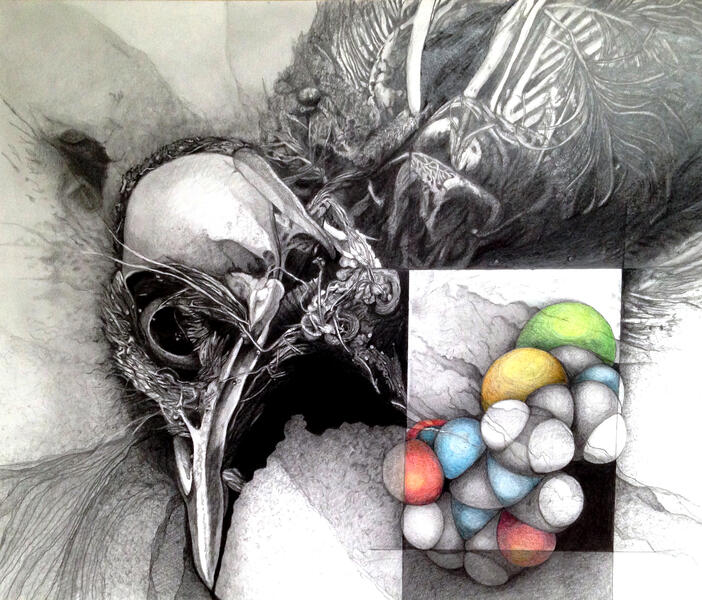 Dead Bird and Neonicotinoid MoleculeDead Bird and Neonicotinoid Molecule
Dead Bird and Neonicotinoid MoleculeDead Bird and Neonicotinoid Molecule -
Parlato Pollinator Bird Feet and Neonicotinoid.JPGDrawing of a dead birdand a Neonicotinoid molecule. Neonicotinoids are a class of insecticides chemically related to nicotine that act on receptors in the nerve synapse. They are toxic to insects, mammals, birds and other higher organisms. Marketed by European chemical giants Syngenta and Bayer, neonics are the most widely used insecticides both in the United States and globally. In a report released a year ago, the EPA basically conceded the case that these pesticides harm bees and other pollinators. They still remain on the market.
-
Parlato Pollinator - Bird Feet DetailDetail - Drawing of a dead bird and a Neonicotinoid molecule. Neonicotinoids are a class of insecticides chemically related to nicotine that act on receptors in the nerve synapse. They are toxic to insects, mammals, birds and other higher organisms. Marketed by European chemical giants Syngenta and Bayer, neonics are the most widely used insecticides both in the United States and globally. In a report released a year ago, the EPA basically conceded the case that these pesticides harm bees and other pollinators. They still remain on the market.
-
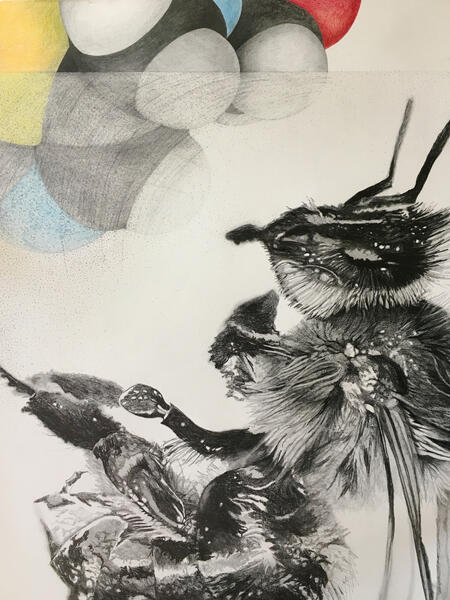 Bee Drawing (In Progress)Drawing of a dead bee and a Neonicotinoid molecule. Neonicotinoids are a class of insecticides chemically related to nicotine that act on receptors in the nerve synapse. They are toxic to insects, mammals, birds and other higher organisms. Marketed by European chemical giants Syngenta and Bayer, neonics are the most widely used insecticides both in the United States and globally. In a report released a year ago, the EPA basically conceded the case that these pesticides harm bees and other pollinators. They still remain on the market.
Bee Drawing (In Progress)Drawing of a dead bee and a Neonicotinoid molecule. Neonicotinoids are a class of insecticides chemically related to nicotine that act on receptors in the nerve synapse. They are toxic to insects, mammals, birds and other higher organisms. Marketed by European chemical giants Syngenta and Bayer, neonics are the most widely used insecticides both in the United States and globally. In a report released a year ago, the EPA basically conceded the case that these pesticides harm bees and other pollinators. They still remain on the market. -
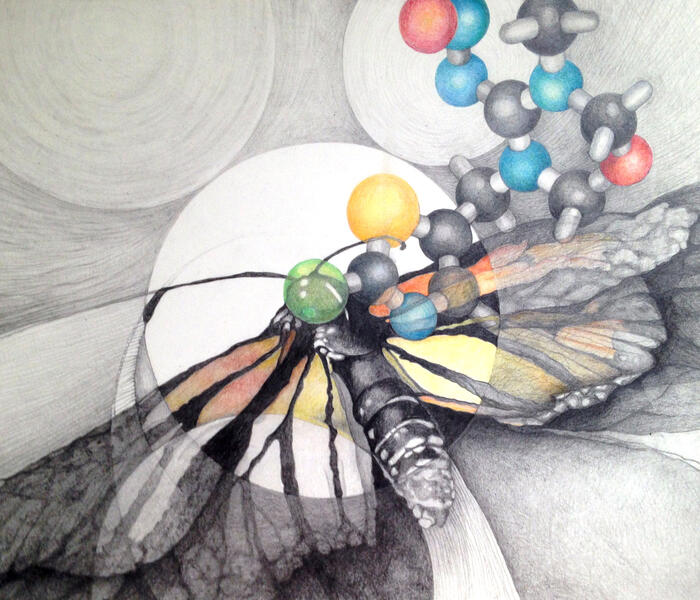 Parlato Pollinator bird 2.jpgDrawing of a dead bird and a Neonicotinoid molecule. Neonicotinoids are a class of insecticides chemically related to nicotine that act on receptors in the nerve synapse. They are toxic to insects, mammals, birds and other higher organisms. Marketed by European chemical giants Syngenta and Bayer, neonics are the most widely used insecticides both in the United States and globally. In a report released a year ago, the EPA basically conceded the case that these pesticides harm bees and other pollinators. They still remain on the market.
Parlato Pollinator bird 2.jpgDrawing of a dead bird and a Neonicotinoid molecule. Neonicotinoids are a class of insecticides chemically related to nicotine that act on receptors in the nerve synapse. They are toxic to insects, mammals, birds and other higher organisms. Marketed by European chemical giants Syngenta and Bayer, neonics are the most widely used insecticides both in the United States and globally. In a report released a year ago, the EPA basically conceded the case that these pesticides harm bees and other pollinators. They still remain on the market. -
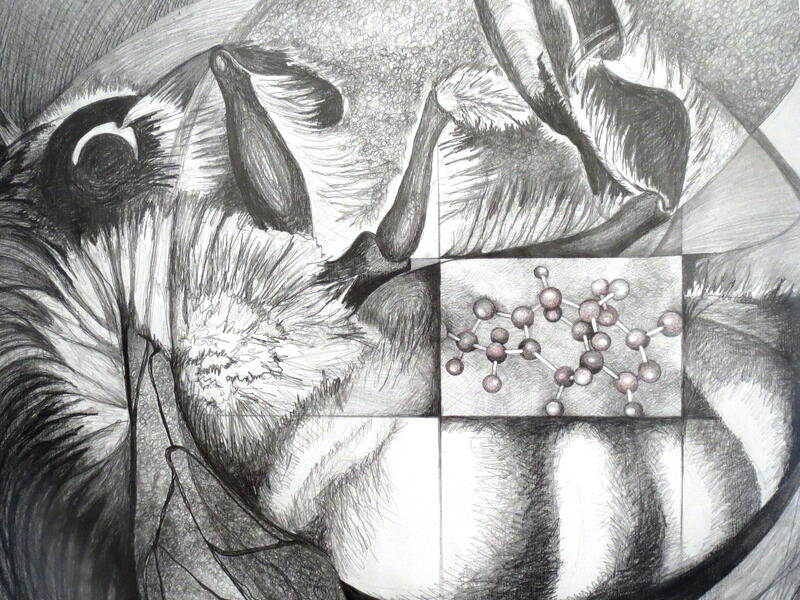 Parlato Pollinator Bee and Neonicotinoid.jpgDrawing of a dead bee and a Neonicotinoid molecule. Neonicotinoids are a class of insecticides chemically related to nicotine that act on receptors in the nerve synapse. They are toxic to insects, mammals, birds and other higher organisms. Marketed by European chemical giants Syngenta and Bayer, neonics are the most widely used insecticides both in the United States and globally. In a report released a year ago, the EPA basically conceded the case that these pesticides harm bees and other pollinators. They still remain on the market.
Parlato Pollinator Bee and Neonicotinoid.jpgDrawing of a dead bee and a Neonicotinoid molecule. Neonicotinoids are a class of insecticides chemically related to nicotine that act on receptors in the nerve synapse. They are toxic to insects, mammals, birds and other higher organisms. Marketed by European chemical giants Syngenta and Bayer, neonics are the most widely used insecticides both in the United States and globally. In a report released a year ago, the EPA basically conceded the case that these pesticides harm bees and other pollinators. They still remain on the market. -
 Parlato Pollinator Bee and Neonicotinoid Detail.jpgDrawing of a dead bee and a Neonicotinoid molecule. Neonicotinoids are a class of insecticides chemically related to nicotine that act on receptors in the nerve synapse. They are toxic to insects, mammals, birds and other higher organisms. Marketed by European chemical giants Syngenta and Bayer, neonics are the most widely used insecticides both in the United States and globally. In a report released a year ago, the EPA basically conceded the case that these pesticides harm bees and other pollinators. They still remain on the market.
Parlato Pollinator Bee and Neonicotinoid Detail.jpgDrawing of a dead bee and a Neonicotinoid molecule. Neonicotinoids are a class of insecticides chemically related to nicotine that act on receptors in the nerve synapse. They are toxic to insects, mammals, birds and other higher organisms. Marketed by European chemical giants Syngenta and Bayer, neonics are the most widely used insecticides both in the United States and globally. In a report released a year ago, the EPA basically conceded the case that these pesticides harm bees and other pollinators. They still remain on the market. -
Dead Bees and Neonicotinoid Molecule (In Progress)Drawing of a dead bee and a Neonicotinoid molecule. Neonicotinoids are a class of insecticides chemically related to nicotine that act on receptors in the nerve synapse. They are toxic to insects, mammals, birds and other higher organisms. Marketed by European chemical giants Syngenta and Bayer, neonics are the most widely used insecticides both in the United States and globally. In a report released a year ago, the EPA basically conceded the case that these pesticides harm bees and other pollinators. They still remain on the market.














